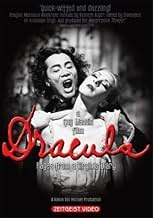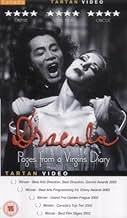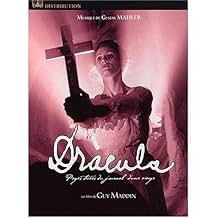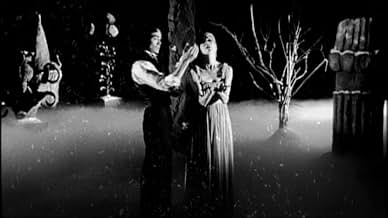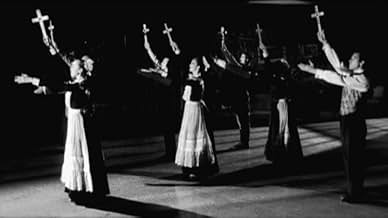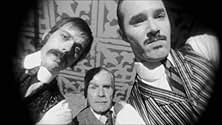Dracula, pages tirées du journal d'une vierge
Original title: Dracula: Pages from a Virgin's Diary
- 2002
- Tous publics
- 1h 13m
IMDb RATING
6.8/10
2.3K
YOUR RATING
A ballet rendition of Bram Stoker's "Dracula", stylized as an Expressionistic silent film.A ballet rendition of Bram Stoker's "Dracula", stylized as an Expressionistic silent film.A ballet rendition of Bram Stoker's "Dracula", stylized as an Expressionistic silent film.
- Awards
- 4 wins & 2 nominations total
Wei-Qiang Zhang
- Dracula
- (as Zhang Wei-Qiang)
Johnny A. Wright
- Jonathon Harker
- (as Johnny Wright)
- Director
- Writers
- All cast & crew
- Production, box office & more at IMDbPro
Featured review
Dracula: Pages from a Virgin's Diary is a silent version of author Bram Stoker's Dracula that also incorporates many ballet-oriented scenes.
My two principle reactions to the film were surprise and delight. I was surprised that the film is so traditional--the silent footage often looks like one is simply watching a film from the 1910s or 1920s. This is heightened by the score, which is extremely conservative, traditional classical music. This surprised me because the Sundance Channel promos for the film kept repeating, ". . . from avant-garde director Guy Maddin". There is not much avant-garde about this film, either in the literal translation of that phrase, as "new wave", or in the more popular sense of "experimental/uncompromisingly different and unusual". Dracula: Pages from a Virgin's Diary is decidedly old wave, and never more experimental, different or unusual than a couple small production design touches that might have been gleaned by anyone who is a big fan of Terry Gilliam's Brazil (1985) and Francis Ford Coppola's Rumble Fish (1983).
Even citing those two influences might be misleading. The Brazil influence is primarily present in a single device--Mrs. Westerna's (Stephanie Ballard) ventilator, and the Rumble Fish influence primarily in the recurrence of red (and occasionally green and gold) within the context of mostly black and white photography (with occasional, very traditional silent film tinting for various scenes). But Dracula: Pages from a Virgin's Diary is so traditional that Maddin frequently even went for German expressionist influenced set design. The sets are wonderful at that, however, and occasional they're more surreal.
It's not that the film is bad for being so traditional, but it took me awhile to adjust my preconceptions, which were misled from the Sundance promo. However, the silent film aspect didn't exactly work well for me, either, and the ballet was a bit blase when it was present, which was less often than I expected. Most of the time I was wondering what the motivation was for the silent film aspect, aside from an exercise in nostalgia and/or cribbing a style of a bygone era, like trying to create a painting that looks almost exactly like Titian, say. On the other hand, it was effective in a couple instances, such as one decapitation-by-shovel (shot from an angle that allowed for minimal gore, to my dismay), where Maddin introduced foley "sound effects" that amped up the impact of the scene. The instances of bright red in the cinematography were also very effective, and not dissimilar to M. Night Shyamalan's The Village (2004), which postdates this film by 2 years.
My delight reaction arose when I realized that much of Dracula: Pages from a Virgin's Diary can be read as an anti-immigration parable. This help explains why Dracula is Chinese here, rather than East European. Under this interpretation, the immigrant Others are invading white Anglo-Saxon shores, usurping authority, "stealing" women and economic power, and so on. It's also notable that Maddin's means of dispatching Dracula in the film is very similar to punishments meted out by Dracula's real-life basis, Vlad Tepes, aka "Vlad the Impaler" (and aka "Dracula" by the way). One popular theory has it that Vlad the Impaler's motivation for his atrocities was primarily to protect the integrity of his Wallachian burg, against what he saw as foreign political and cultural invaders. This makes Dracula's finale in the film fittingly ironic in light of the anti-immigration subtext.
Maddin's film is also interesting for presenting the story in two halves, the first solely centered on Lucy Westerna (Tara Birtwhistle), and the second on Jonathan Harker (Johnny Wright) and Mina (Cindy Marie Small). A pervert rendition of Dr. Van Helsing (Dave Moroni) was also unusual and amusing, but Renfield (Brent Neale) was mostly wasted.
Of course a potential audience for Dracula: Pages from a Virgin's Diary has to be amenable to silent films, and not averse to ballet or traditional classical music. If you fit that bill and you have a taste for horror or an interest in Dracula, this film may be just up your alley.
My two principle reactions to the film were surprise and delight. I was surprised that the film is so traditional--the silent footage often looks like one is simply watching a film from the 1910s or 1920s. This is heightened by the score, which is extremely conservative, traditional classical music. This surprised me because the Sundance Channel promos for the film kept repeating, ". . . from avant-garde director Guy Maddin". There is not much avant-garde about this film, either in the literal translation of that phrase, as "new wave", or in the more popular sense of "experimental/uncompromisingly different and unusual". Dracula: Pages from a Virgin's Diary is decidedly old wave, and never more experimental, different or unusual than a couple small production design touches that might have been gleaned by anyone who is a big fan of Terry Gilliam's Brazil (1985) and Francis Ford Coppola's Rumble Fish (1983).
Even citing those two influences might be misleading. The Brazil influence is primarily present in a single device--Mrs. Westerna's (Stephanie Ballard) ventilator, and the Rumble Fish influence primarily in the recurrence of red (and occasionally green and gold) within the context of mostly black and white photography (with occasional, very traditional silent film tinting for various scenes). But Dracula: Pages from a Virgin's Diary is so traditional that Maddin frequently even went for German expressionist influenced set design. The sets are wonderful at that, however, and occasional they're more surreal.
It's not that the film is bad for being so traditional, but it took me awhile to adjust my preconceptions, which were misled from the Sundance promo. However, the silent film aspect didn't exactly work well for me, either, and the ballet was a bit blase when it was present, which was less often than I expected. Most of the time I was wondering what the motivation was for the silent film aspect, aside from an exercise in nostalgia and/or cribbing a style of a bygone era, like trying to create a painting that looks almost exactly like Titian, say. On the other hand, it was effective in a couple instances, such as one decapitation-by-shovel (shot from an angle that allowed for minimal gore, to my dismay), where Maddin introduced foley "sound effects" that amped up the impact of the scene. The instances of bright red in the cinematography were also very effective, and not dissimilar to M. Night Shyamalan's The Village (2004), which postdates this film by 2 years.
My delight reaction arose when I realized that much of Dracula: Pages from a Virgin's Diary can be read as an anti-immigration parable. This help explains why Dracula is Chinese here, rather than East European. Under this interpretation, the immigrant Others are invading white Anglo-Saxon shores, usurping authority, "stealing" women and economic power, and so on. It's also notable that Maddin's means of dispatching Dracula in the film is very similar to punishments meted out by Dracula's real-life basis, Vlad Tepes, aka "Vlad the Impaler" (and aka "Dracula" by the way). One popular theory has it that Vlad the Impaler's motivation for his atrocities was primarily to protect the integrity of his Wallachian burg, against what he saw as foreign political and cultural invaders. This makes Dracula's finale in the film fittingly ironic in light of the anti-immigration subtext.
Maddin's film is also interesting for presenting the story in two halves, the first solely centered on Lucy Westerna (Tara Birtwhistle), and the second on Jonathan Harker (Johnny Wright) and Mina (Cindy Marie Small). A pervert rendition of Dr. Van Helsing (Dave Moroni) was also unusual and amusing, but Renfield (Brent Neale) was mostly wasted.
Of course a potential audience for Dracula: Pages from a Virgin's Diary has to be amenable to silent films, and not averse to ballet or traditional classical music. If you fit that bill and you have a taste for horror or an interest in Dracula, this film may be just up your alley.
- BrandtSponseller
- Feb 6, 2005
- Permalink
Storyline
Did you know
- TriviaSarah Murphy-Dyson's debut.
- ConnectionsReferenced in Guy Maddin: Son Winnipeg (2014)
- SoundtracksSymphony #1 (excerpts)
By Gustav Mahler
- How long is Dracula: Pages from a Virgin's Diary?Powered by Alexa
Details
- Release date
- Country of origin
- Official site
- Language
- Also known as
- Dracula: Pages from a Virgin's Diary
- Filming locations
- Production companies
- See more company credits at IMDbPro
Box office
- Budget
- $1,600,000 (estimated)
- Gross US & Canada
- $55,365
- Opening weekend US & Canada
- $4,784
- May 18, 2003
- Gross worldwide
- $55,365
- Runtime1 hour 13 minutes
- Color
- Sound mix
- Aspect ratio
- 1.85 : 1
Contribute to this page
Suggest an edit or add missing content

Top Gap
By what name was Dracula, pages tirées du journal d'une vierge (2002) officially released in Canada in English?
Answer



